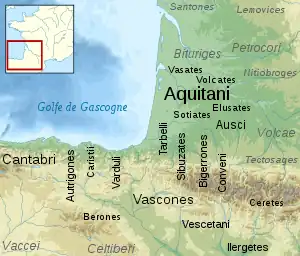
The Bigerriones or Begerri were an Aquitani tribe dwelling in present-day Bigorre during the Iron Age.
They were subjugated in 56 BC by the Roman forces of Caesar's legatus P. Licinius Crassus.
Name
They are mentioned as Bigerriones by Caesar (mid-1st c. BC),[1] and as Begerri (var. Begerbi, Bebergi, Bergebi) by Pliny (1st c. AD).[2][3]
The Bigorre region, attested as Begorra ca. 400 AD, is named after the tribe.[4]
Geography
The Bigerriones lived in the Bigorre region, in the northern foreland of the Pyrenees.[5][6] Their territory was located north of the Onobrisates, south of the Atures, Elusates and Auscii, east of the Venarni, and west of the Volcae Tectosages.
Their chief town was known as Bigorra Castrum (modern Saint-Lézer).[5]
Culture
It is believed the Bigerriones spoke a form or dialect of the Aquitanian language, a precursor of the Basque language.[7]
See also
References
- ↑ Caesar. Commentarii de Bello Gallico, 3:27.
- ↑ Pliny. Naturalis Historia, 4:108.
- ↑ Duval 1989, pp. 724–725, 736.
- ↑ Nègre 1990, p. 1202.
- 1 2 Duval 1989, pp. 724–725.
- ↑ Frezouls 2006.
- ↑ Jacques Lemoine, Toponymie du Pays Basque Français et des Pays de l'Adour, Picard 1977, ISBN 2-7084-0003-7
Bibliography
- Duval, Paul-Marie (1989). "Les peuples de l'Aquitaine d'après la liste de Pline". Travaux sur la Gaule (1946-1986). Vol. 116. École Française de Rome. pp. 721–737. ISBN 9782728301676.
- Frezouls, Edmond (2006). "Bigerriones". Brill's New Pauly. doi:10.1163/1574-9347_bnp_e217060.
- Nègre, Ernest (1990). Toponymie générale de la France. Librairie Droz. ISBN 978-2-600-02883-7.
- Talbert, Richard J. A. (2000). Barrington Atlas of the Greek and Roman World. Princeton University Press. ISBN 978-0691031699.